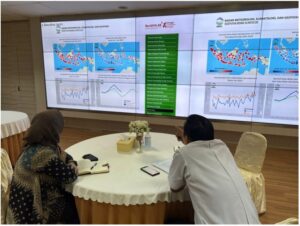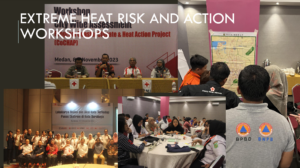CoCHAP: Indonesia
COCHAP Cities in Indonesia
Both Medan and Surabaya cities in Indonesia are implementing the coastal hazard resilience component of the COCHAP
Medan is the capital and largest city of the Indonesian province of North Sumatra outside Java, and its fourth largest altogether. The population more than quadrupled in less than fifty years, growing from 568,000 in 1968 to 2.1 million in 2010. As of 2020, Medan had a population of 2,435,252 and the larger metropolitan area had a population of 4,756,863.
The nearby Strait of Malacca, Port of Belawan, and Kualanamu International Airport make Medan a regional hub and multicultural metropolis, acting as a financial centre for Sumatra and a gateway to the western part of Indonesia. About 60% of the economy in North Sumatra is backed by trading, agriculture, and processing industries, including exports from its 4 million acres of palm oil plantations. As of the 2020 Census, Medan had a population of 2,435,252 within its city limits; the official population estimate as of mid 2023 was 2,474,166 - comprising 1,231,673 males and 1,242,493. When the surrounding urban area is included, the population is over 3.4 million, making it the fourth largest urban area in Indonesia.
The Medan metropolitan area was recognized as an Indonesian National Strategic Region (Indonesian: Kawasan Strategis Nasional) by Government Regulation No 28/2008. As a major commercial and economic hub of Indonesia, Medan is a centre for the production and trade of commodities including cinnamon, tobacco, tea, coffee, rubber, and palm oil. It also has a growing manufacturing sector, producing goods such as cars, machinery, tile, and paper and pulp.
Surabaya is the capital city of the Indonesian province of East Java and the second-largest city in Indonesia, after Jakarta. Located on the northeastern corner of Java island, on the Madura Strait, it is one of the earliest port cities in Southeast Asia. The city had a population of 2,874,314 within its city limits at the 2020 census. With 3,009,286 people living in the city as of mid 2023 (comprising 1,490,358 males and 1,518,928 females) and over 10 million in the extended Surabaya metropolitan area, according to the latest official estimate, Surabaya was the second-largest metropolitan area in Indonesia. Surabaya is also ASEAN's 7th largest economy.
Surabaya city has won many awards in the field of environment and city planning both nationally and internationally. These awards have included Adipura, Adipura kencana, Adiwiyata, Wahyu Tata Nugraha, and other green awards, the Adipura Cup, which Surabaya won several times in the 1980s and 1990s, the Adipura Kencana trophy, the cleanest metropolitan city category in the 1990s and in the period of 2010 to 2017, seven consecutive times, as well as the Adipura trophy, plenary in 2016.The city also received several awards from the central government as one of the major cities with the best air quality in Indonesia. Surabaya in 2012 has won the award "City of the Best Participation in the Asia Pacific" by Citynet for the success of the city government and people's participation in managing the environment.
Surabaya features a tropical wet and dry climate with distinct wet and dry seasons. The city's wet season runs from October through May, while the dry season covers the remaining four months. Unlike many cities and regions with a tropical wet and dry climate, average high and low temperatures are very consistent throughout the year, with an average high temperature of around 31 °C and average low temperatures around 23 °C.
From Challenge to Change: The journey of Extreme Heat in Indonesia begins here
In the tapestry of natural disasters woven into the landscape of Indonesia through Law No. 24 of 2007, there are no elements of extreme heat or heat waves. However, the absence of these elements does not diminish their presence in almost all regions of Indonesia, especially in areas like Surabaya and Medan. As temperatures rise, so does the urgency to act. Armed with several studies and reports, including the article "Urban Heat Stress in Indonesia (1983-2016)", the CoCHAP project embarked on a mission to address this glaring gap. However, in its early implementation, the project faced significant hurdles: a lack of recognition that extreme heat is an urgent issue, both by the central and local governments.
In response to this challenge, the CoCHAP team in Indonesia understood the crucial importance of government involvement. Through collaborative efforts with key stakeholders such as BNBP (National Disaster Management Agency), BAPPENAS/BAPPEDA (National Development Planning Agency), BMKG (Meteorology, Climatology, and Geophysics Agency), and KLHK/BLHD (Ministry of Environment and Forestry), various workshops were conducted. These sessions led to a consensus: a scientific study on Extreme Heat Risks is crucial, serving as the basis for further interventions.
Led by BMKG, CoCHAP will engage stakeholders ranging from health ministries to industries in collaborative meetings and workshops. The goal is to understand and address health, economic, and labor impacts, fostering dialogue and sharing best practices.
 The decision to appoint BMKG to lead this national-level study garnered widespread praise. A. Fachri Radjab, Head of the Climate Change Information Center, commended this move, acknowledging BMKG's direct involvement from planning to outcomes. This marked a significant departure from the norm, where BMKG often served merely as a data provider, signaling an important shift in Indonesia's climate change study landscape. Further validation came from Sezin Tokar, Senior Hydrometeorological Hazard Advisor at the United States Agency for International Development (USAID). Her optimism during her visit to Indonesia bolstered the CoCHAP team's spirits, affirming the carefully crafted strategy for sustainability.
The decision to appoint BMKG to lead this national-level study garnered widespread praise. A. Fachri Radjab, Head of the Climate Change Information Center, commended this move, acknowledging BMKG's direct involvement from planning to outcomes. This marked a significant departure from the norm, where BMKG often served merely as a data provider, signaling an important shift in Indonesia's climate change study landscape. Further validation came from Sezin Tokar, Senior Hydrometeorological Hazard Advisor at the United States Agency for International Development (USAID). Her optimism during her visit to Indonesia bolstered the CoCHAP team's spirits, affirming the carefully crafted strategy for sustainability.
Through this collaboration, a significant milestone will be achieved: the creation of a comprehensive understanding of Extreme Heat, its risks, and its nationwide impacts. Minimum threshold values for extreme heat events in Medan and Surabaya will be established, alongside the development of a three-tier Early Warning System for extreme heat at the city level. These achievements lay a strong foundation, poised to significantly alter the trajectory of extreme heat events in Indonesia. As the CoCHAP project progresses, it not only ensures responses to current challenges but also provides a blueprint for climate resilience in the future.
Progress and Impact
 In Indonesia, (as of April 2024 -latest at the top), we...
In Indonesia, (as of April 2024 -latest at the top), we...
Are preparing for conducting a nation-wide heat thresholds study in partnership with the BMKG.
Preparing for a heat awareness campaign in both cities in June 2024.
Developed the Heat Risk Perception Survey to be conducted in both cities in May-June.
Completed the Urban Heat risk In Indonesia Study outlining the heat trends and hot spots based on a remote data analysis.
Together with the coalition members, designed the detailed Project activities and developed a work plan in each city and conducted Extreme Heat Risk and Action workshops in two cities, Medan and Surabaya with coalition members.
Following the stakeholder mapping and engagement process, set-up city heat resilience coalitions in Medan and Surabaya with a strong endorsement and leadership from city governments and Indonesia National Meteorological Agency (BMKG).
Climate Context
Indonesia is a maritime continent, where it is hot and humid year-round. The climate is tropical, with the highest rainfall occurring in its low-lying areas. Small annual variation in temperature (even with varying elevation (mountains average 23°C, while coastal areas average 28°C)
Wet season: November to April (monsoons Oct-May) Drier season: June to September 🡪 note still receives rainfall during this time, just less (maybe 40-50% less) than wetter months
Larger annual precipitation variability; lower coastal areas average 1,800 mm, mountains average 3,200 mm, highest elevations over 6,000 mm.
Large ENSO influence: El Niño usually brings drier conditions; La Niña events generally brings wetter conditions.
Rapid urbanization (71% of the country’s population is expected to live in urban areas by 2050) and the impacts of climate change are likely to exacerbate the existing extreme weather events and impact the most vulnerable groups, including outdoor workers and also indoor workers with limited cooling facilities, low income families and homeless groups with inadequate house ventilation and lack of water supply. Western Indonesia is often subject to prolonged dry periods. The number of dry days across the entire country is projected to significantly increase in the latter half of the 21st century.
Read more on Indonesia Heat Risk Analysis.
Resources:
WB Climate Change Knowledge Portal/Indonesia
Click here to enter text.USAID Climate Risk Profile: Indonesia
https://www.usaid.gov/climate/asia/indonesia
USAID CC Fact Sheet: Indonesia
The impact of urban heat islands Assessing vulnerability in Indonesia
